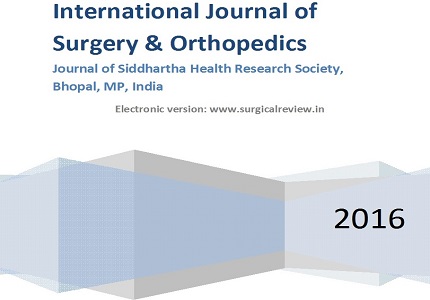A prospective study of calorimetric estimation of blood loss in TURP cases
Abstract
Introduction: BEP is hyperplasia of prostatic stromal epithelial cells to form discreate nodules in transitional zone of prostate. It leads to constriction of urethral opening which gives rise to associated lower urinary tract symptoms such as frequency, urgency, nocturia. Initially disease can be managed by drug treatment but eventually most of the patients require surgical management. TURP remains gold standard treatment. Blood loss during and after procedure is major problem. This study was planned to evaluate the approximate blood loss with the help of simple technique of colorimatry.
Method: This study is carried out on 50 patients with BEP who underwent TURP in our institute from October 2014 and June 2015. Irrigation fluid collected during TURP, post operative day 1 & 2 subjected to calorimetric estimation of blood loss using Drabkin’s reagent.
Results: The results were suggestive of approximate average blood loss during TURP procedure as 267 ml, post operative day 1 blood loss 98.9ml and post operative day 2 loss was 58.1ml. However the average blood loss changes according to the size of prostate and duration of the procedure.
Conclusion: calorimetric estimation of blood loss during and post operative period is an easy, economically feasible, quick method to guide the management of blood requirement for the patient. This can be useful in patients with BEP and bleeding diathesis.
Downloads
References
2. Shrestha BM, Prasopshanti K, Matanhelia SS, Peeling WB. Blood loss during and after transurethral resection of prostate: a prospective study. Kathmandu Univ Med J (KUMJ) [Internet]. 2008 Apr 9;6(23):329–34.
3. Ohta N, Robertson AR. Colorimetry: Fundamentals and Applications. Colorimetry: Fundamentals and Applications. 2006. 1-334 p.
4. Rassweiler J, Teber D, Kuntz R, Hofmann R. Complications of Transurethral Resection of the Prostate (TURP)-Incidence, Management, and Prevention. Eur Urol. 2006;50(5):969–80. [PubMed]
5. Ungjaroenwathana W, Bunyaratavej C, Tosukhowong P, Dissayabutra T. Estimation of blood loss in transurethral resection of prostate (TUR-P) by urine-strip. J Med Assoc Thai. 2007 Nov;90(11):2409-15. [PubMed]
6. Ekengren J, Hahn RG. Blood loss during transurethral resection of the prostate as measured with the HemoCue photometer. Scand J Urol Nephrol 1993; 27: 501–7. [PubMed]
7. Hahn, R. G., Fagerström, T., Tammela, T. L.J., Van Vierssen Trip, O., Beisland, H. O., Duggan, A. and Morrill, B. (2007), Blood loss and postoperative complications associated with transurethral resection of the prostate after pretreatment with dutasteride. BJU International, 99: 587–594. doi:10.1111/j.1464-410X.2006.06619.x [PubMed]
8. Malhotra V, Diwan S. Anesthesia and the renal and genitourinary systems. In: Miller RD, editor. Anesthesia. 5th Edn. Philadelphia: Churchill Livingstone; 2000. p. 1947-9.
9. Ahyai SA, Gilling P, Kaplan SA, Kuntz RM, Madersbacher S, Montorsi F, et al. Meta-analysis of functional outcomes and complications following transurethral procedures for lower urinary tract symptoms resulting from benign prostatic enlargement. Eur Urol [Internet]. 2010;58(3):384–97.
10. Moorthy H K, Philip S. TURP syndrome - current concepts in the pathophysiology and management. Indian J Urol 2001;17:97-102.
11. Descazeaud A, Azzousi AR, Ballereau C, Bruyere F, Robert G, Delongchamps NB,Devonec M, Dumonceau O, Fourmarier M, Saussine C, Berger J, de la Taille A,Haillot O; Committee for Lower Urinary Tract Symptoms of the French Association of Urology.. Blood loss during transurethral resection of the prostate as measured by the chromium-51 method. J Endourol. 2010 Nov;24(11):1813-6. doi:10.1089/end.2010.0174.
12. KIROLLOS, M.M. and CAMPBELL, N. (1997), Factors influencing blood loss in transurethral resection of the prostate (TURP): auditing TURP. British Journal of Urology, 80: 111–115. doi:10.1046/j.1464-410X.1997.00253.x [PubMed]

Copyright (c) 2016 Author (s). Published by Siddharth Health Research and Social Welfare Society

This work is licensed under a Creative Commons Attribution 4.0 International License.


 OAI - Open Archives Initiative
OAI - Open Archives Initiative


















 Therapoid
Therapoid

